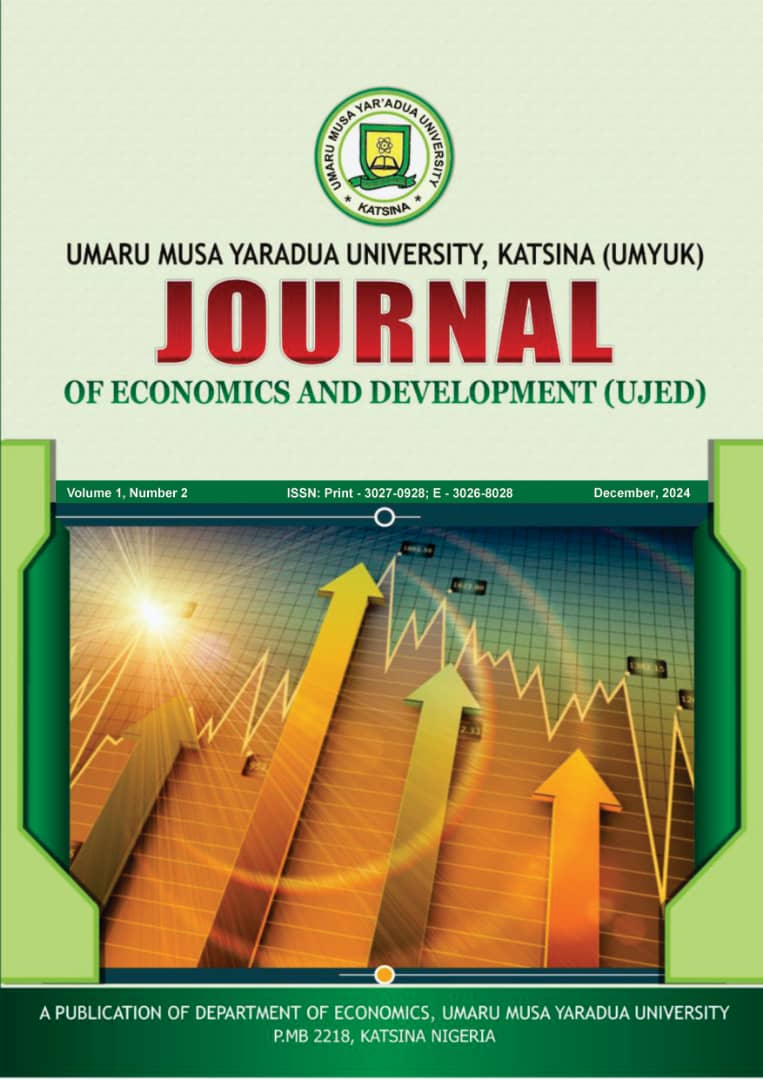Dynamics of Banking Fraud in Northwestern Nigeria: Prevalence, Impacts, and Mitigation Strategies
Main Article Content
Abstract
Banking fraud poses a significant threat to financial stability worldwide, and Nigeria is no exception. This study investigates the dynamics of banking fraud in Northwestern Nigeria, focusing on Sokoto, Zamfara, and Kebbi States, regions with distinct socio-economic contexts and banking activities. Data were gathered from banking customers, staff, and law enforcement officials using structured questionnaires. The analysis, conducted using SPSS and logistic regression, identified critical demographic predictors of fraud experiences, offering a deeper understanding of the factors influencing fraud vulnerability. Findings reveal that 70.5% of respondents have experienced fraud, with Internet banking fraud being the most prevalent type (49.7%). Younger respondents (aged 25–34) and female participants were more likely to experience fraud, while higher education levels were associated with reduced vulnerability. Regional disparities were evident, with Sokoto emerging as a hub of banking activity and fraud risk, necessitating sophisticated fraud detection systems. In contrast, Zamfara and Kebbi exhibited lower fraud prevalence but required targeted education campaigns to address local challenges. The study recommends adopting advanced cybersecurity technologies, strengthening customer-centric awareness initiatives, and enhancing regulatory frameworks to rebuild trust in financial systems. These measures are essential for promoting a secure and resilient financial ecosystem in Northwestern Nigeria.
Article Details

This work is licensed under a Creative Commons Attribution-NonCommercial 4.0 International License.
References
ACFE. (2021). Report to the Nations: 2021 Global Study on Occupational Fraud and Abuse. Association of Certified Fraud Examiners.
Adesina, K., & Odusanya, I. (2017). Financial Fraud in Nigeria: A Critical Analysis of the Causes and Effects. International Journal of Accounting and Financial Reporting.
Adewale, A. (2019). Institutional Weaknesses and Financial Fraud in Nigeria: A Review of Challenges and Remedies. Journal of Banking and Finance, 15(2), 45-58.
Akindele, R. I. (2011). Fraud as a Negative Catalyst in the Nigerian Banking Industry. Journal of Emerging Trends in Economics and Management Sciences (JETEMS), 2(5), 357–363.
Bell, E., & Bryman, A. (2007). The Ethics of Management Research : An Exploratory Content Analysis. British Journal of Management, 18(June), 63–77. https://doi.org/10.1111/j.1467-8551.2006.00487.x
CBN. (2023). Central Bank of Nigeria: 2022 Financial Fraud Statistics.
Clementina, K., & Isu, I. G. (2017). Security Challenge , Bank Fraud and Commercial Bank Performance in Nigeria : Journal of Business and Management Security Challenge , Bank Fraud and Commercial Bank Performance in Nigeria : An Evaluation. Journal of Business Management, June 2016. https://doi.org/10.12735/jbm.v5n2p01
Cressey, D. R. (1953). Other People’s Money: A Study in the Social Psychology of Embezzlement.
Creswell, J. W., & Creswell, J. D. (2017). Research design: Qualitative, quantitative, and mixed methods approaches. Sage publications.
Enofe, O. A., Abilogun, T. ., Omoolorun, A. J., & Elaiho, E. M. (2017). Bank Fraud and Preventive Measures in Nigeria : An Empirical Review. International Journal of Academic Research in Business and Social Sciences, 7(7). https://doi.org/10.6007/IJARBSS/v7-i7/2021
Field, A. (2017). Discovering Statistics Using IBM SPSS Statistics (5th ed.). SAGE Publications.
Folowosele, F. A., & Ikpefan, O. A. (2021). Electronic Fraud : An emerging cause of Bank Failure in nigerian deposit money Banks. International Journal of Economics and Management Systems, 6, 340–356.
Fowler, F. J. (2014). Survey Research Methods. Thousand Oaks, CA: SAGE Publications.
FTC. (2023). Consumer Sentinel Network: Data Book 2022. Federal Trade Commission.
Hosmer, J. D. W., Lemeshow, S., & Sturdivant, R. X. (2013). Applied logistic regression. John Wiley & Sons.
Ibietan, J., & Olutayo, O. (2018). (2018). Financial Fraud and Banking Sector Stability in Nigeria. Journal of Accounting, Finance, and Auditing Studies.
Idolor, E. J. (2010). Bank Frauds in Nigeria: Underlying Causes, Effects and Possible Remedies. African Journal of Accounting, Economics, Finance and Banking Research, 6(6), 62–80.
Inaya, L., & Isito, E. O. (2016). An Empirical Analysis of Social Impact of Fraud on the Nigerian Banking Industry. Research Journal of Finance and Accounting, 7(4), 12–17.
Manyo, T. S., Walter, M. H., Bassey, O. E., Wonah, O. G., Bekom, A., Ekpo, N. S., & Chike, E. C. (2023). Effect of Fraud on Commercial Banks ’ Performance in Nigeria. ParadigmAcademic Press, 2(2), 69–78. https://doi.org/10.56397/FMS.2023.04.08
Mawutor, J. K. M., Enofe, A., & Embele, K. (2019). Fraud and Performance of Deposit Money Banks. Accounting and Finance Research, 8(2). https://doi.org/10.5430/afr.v8n2p202
Muritala, T., Ijaiya, M., Afolabi, O., & Yinus, A. (2020). Fraud and Bank Performance in Nigeria – Var Granger Causality Analysis. Financial Internet Quarterly, 16(1), 20–26. https://doi.org/10.2478/fiqf-2020-0003
NIBSS. (2023). Nigeria Inter-Bank Settlement System (NIBSS): Fraud Statistics Report for 2022.
Olelewe, C. A., & Onwumere, J. U. (2024). The Impact of Internet Banking on Bank Fraud in Nigeria. Asian Journal of Economics, Business and Accounting, 24(5), 510–524. https://doi.org/10.9734/AJEBA/2024/v24i51326
Ololade, B. M., Salawu, M. K., & Adekanmi, A. D. (2020). E-Fraud in Nigerian Banks : Why and How ? Journal of Financial Risk Management, 9, 211–228. https://doi.org/10.4236/jfrm.2020.93012
Owolabi, S. (2019). Regulatory Framework and Banking Sector Stability in Nigeria. European Journal of Accounting, Auditing and Finance Research.
Oyewunmi, O. A. (2020). The Impact of Financial Fraud on Nigeria’s Economic Development. African Development Perspectives Yearbook.
Pallant, J. (2020). SPSS survival manual: A step by step guide to data analysis using IBM SPSS. Routledge.
Scott, W. R. (1995). Institutions and organizations. Thousand Oaks, CA: Sage Publications.
Tabachnick, B. G., & Fidell, L. S. (2019). Using Multivariate Statistics (7th ed.). Pearson.
Transparency International. (2022). Corruption Perceptions Index.
UK Finance. (2022). Fraud the Facts 2022.
